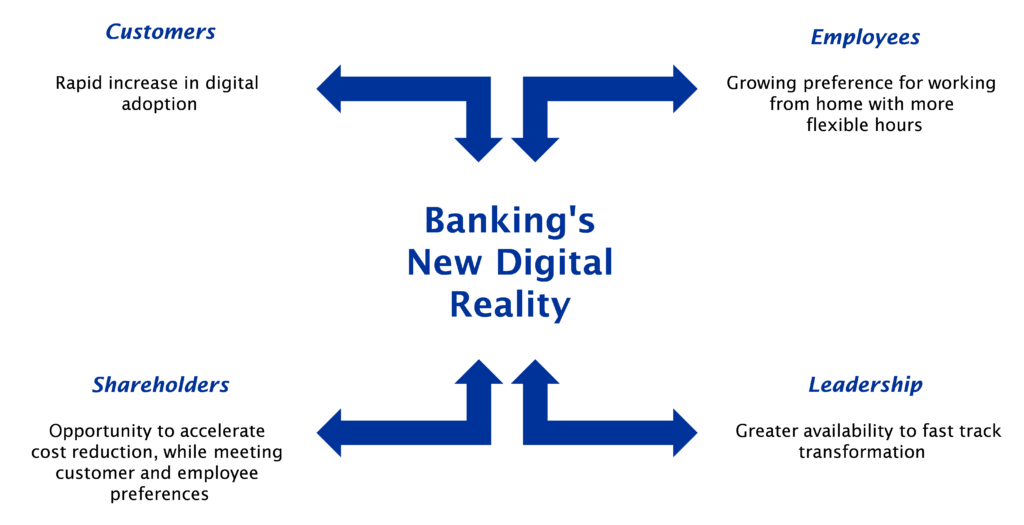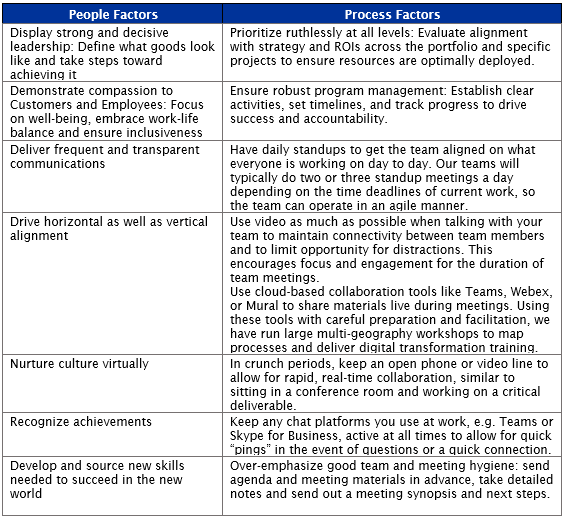Insight
GenAI – A Catalyst to Transform the Operating Model
Private Equity Portfolio COOs face increasing pressure to unlock value from GenAI, yet the reality is sobering: only
Learn More

For many years banks have been on a digital journey to improve service and efficiency, but success has wildly been varied – customer adoption hasn’t universally achieved the desired levels impacting cost efficiency.
Covid-19 has provided a shock to their system which changed the dynamic and made it clear that inertia was not an option. Digital adoption has rapidly increased at the expense of physical channels. As the CEO of a bank highlighted “Digital sales have increased to 75% of total sales from 25% earlier in the year, and they have achieved a shift in customer behavior which would have taken 10 years in 2 months.” Concurrently, the work environment has also dramatically changed– employees can and want to continue working remotely.
This presents banks with an opportunity to capitalize on these trends by accelerating digitization and cost reduction. Such transformation can be fast tracked, especially as leadership, having understood first-hand its benefits, will back initiatives to drive this change with far greater conviction.
This is banking’s new digital reality. With all the stakeholders, i.e. customers, employees, shareholders, and leadership, all aligned around this mutual goal, banks have a window of opportunity to react rapidly and lock in this digital adoption, thereby avoiding reversion to the old world.
Customer and Employee Preferences have Changed
The current environment has shifted customers online for convenience and safety at a faster pace than ever with greater than 27% more likely to use digital channels.
The current work environment has forced the pivot of traditional office and call center roles into work from home positions, resulting in several positive developments. The technology has been stress-tested, and employees have enjoyed the work from home experience. Indeed, 66% of these employees would prefer to carry on working more remotely. Likewise, 70% of employees who have been permitted more flexible hours during Covid-19 would like to continue working in this manner.
From an employer perspective, this environment has resulted in a more flexible, engaged workforce that can provide extra availability to customers and management alike for specialist as well as routine activities. In addition, Banks can now access new talent pools leading to a more skilled workforce.
Now is the Time to React and Lock in These Changes in this Window
Banks need to embrace the customer and employee changes to make this an inflection point for the new digital reality. There are four key priorities for banks:
It is critical for banks to react rapidly in this window to lock in this change now.
Driving Remote Transformation Takes Discipline
Delivering transformation under normal circumstances is hard. In today’s remote environment, that difficulty is amplified. In our experience of driving both large scale global transformation and smaller changes in this environment, success requires a calculated approach that considers both people and process – higher focus on people dimensions; robust discipline across the process of change delivery, supplemented with collaborative technology. Being flexible and adapting quickly is key.

The companies who will succeed are those who are rapidly embracing the change in customer and employee behavior, exercising discipline, and building operating models with agility and flexibility. These leaders are already working on what they need to do to improve their outcomes, and with it, grow market share.
SSA & Company can Help
Digital adoption has been a growing trend across financial services. The current environment has turbocharged this trend, and customers are now 27% more likely to use mobile, 28% more likely to use online, and 37% less likely to use a branch. Banks must use this as a catalyst to accelerate digitization and lock in this increase in digital adoption. SSA & Company is helping Financial Services companies re-invent, re-focus, and re-energize their businesses in these challenging times, driving transformation efficiently and effectively remotely.
Let us help you accelerate your digital transformation. You can learn more about our work in Financial Services here.
Customer research provided by Consumer Intelligence: Sample = 1,045, May 2020
Private Equity Portfolio COOs face increasing pressure to unlock value from GenAI, yet the reality is sobering: only
Learn MoreNick Kramer sheds light on cybersecurity questions every CISO must answer in this CSO article. He says CISOs
Learn MoreMatt Katz details how leading furniture retailers are thinking about industry stagnation in this Retail Dive article. Home
Learn More